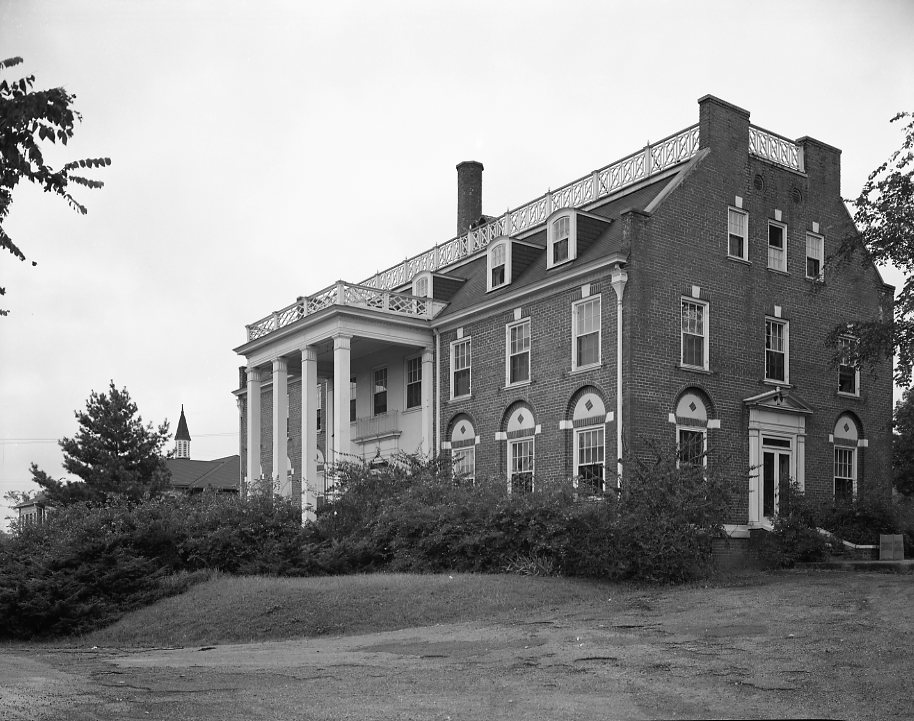Among the earlier settlers of the Beverly community were William and Nancy McCampbell Anderson, second-generation Irish immigrants from Rockbridge County, Virginia. Their son, Isaac Anderson (1780-1857), came with his family to an area they called Grassy Valley. That area between Sharp’s Ridge and Black Oak Ridge was described as “a huge prairie, covered with tall grass, through which game and cattle could be tracked with almost as much accuracy as if it had been snow.”
The Rev. Isaac Anderson, who had been educated as a Presbyterian minister in Lexington, Virginia, started a school in 1802 in a cabin on his property. The school, called Union Academy, was just off present-day Murphy Road. During its 10-year existence there, the school became known for its academic excellence. Among its distinguished alumni were two future governors, John Reynolds, the fourth governor of Illinois (1830-1834), and the illustrious Sam Houston, the seventh governor of Texas (1859-1861).
In 1812, Anderson was called to minister to the New Providence Presbyterian Church in Maryville. He moved the school there, and eventually it became Maryville College.
The Scots-Irish Andersons and McCampbells were joined in Beverly by a group of French-Swiss families who came between 1845 and 1848. The Chevannes, Gouffon and Truan families came first, but they were eventually joined by the Stoffell, Dovat, Buffatt, Babelay and other families. The rich farmland enabled the industrious families to establish many productive gardens, orchards and several dairy farms.
The Crawford family was also very important to the community’s early development. William D. Crawford (1813-1859) and his wife, Lucinda Anderson, had a large farm and log cabin at the intersection of present-day Beverly Road and Tazewell Pike. They built a larger, hand-made brick home on the property in 1858 which is still standing.
Their oldest child, James Moses Crawford (1852-1941), assumed ownership of the stately home when his father died only one year later. James Crawford attended Maryville College and then farmed and ran a grocery store across the pike from his house. A branch post office was established in the store and remained there from 1880 to 1905 with Crawford as postmaster.
Access to markets in Knoxville and northward improved dramatically when, in 1885, a railroad station was built in Beverly near the present-day intersection of Beverly Road and Greenway Drive. It eventually became one of the 11 stops on the Knoxville and Bristol Railroad which took over the line in 1898 and ran until 1903 when it was absorbed by the Southern Railway. The K&B connected Knoxville to Morristown via Corryton, Rutledge and Bean Station.
A major addition to the Beverly community occurred when the 126-acre Freestone Farm with its free-flowing spring, its park-like grove of trees and its fine herd of Jersey cows was chosen as the site for the Beverly Hills Sanatorium. It was planned to cope with the high incidence of tuberculosis. At the time, the death rate from tuberculosis was greater than that from cancer, strokes and heart disease. In the 1920s, there were as many as 1,400 active cases in Knox County per year and no place to house them as the hospitals would not admit them.
Since 1912 when the property was purchased, Dr. H.P. Coile (1852-1922), Knoxville city physician, had led a valiant effort to raise funds for the construction of the recommended 32-bed hospital with plans to expand to 184 beds. The figure was based on the death rate from the disease in Knox County.
A breakthrough came in 1922 when Dr. Herbert Acuff, another ardent supporter of the movement, became president of the Civitan Club and the club agreed to take over the project. The Knox County Sanatorium Inc. was organized with many prominent citizens on its board, and 40 teams were formed to fan out into the county and raise $100,000 for the project. The contract was let in 1923 and the first patient was admitted on June 3, 1924. Over its first 25 years, the sanatorium cared for 3,348 patients, many of them spending as much as a year in treatment. Eventually, it had cared for 5,295 total patients.
By the early 1950s, the sanatorium had a bed capacity of 145 patients. Later, with the advent of effective drugs to treat the disease, the facility was released to the state and the name was changed to the East Tennessee Tuberculosis Hospital.
In 1959, the Convalescent Unit of Beverly Hills Sanatorium was opened, with a capacity of 50 patients, 25 males and 25 females. The University of Tennessee Memorial Hospital and Research Center was specifically given high priority to access beds in the new units.
Later, its mission was expanded when it became the East Tennessee Chest Hospital with some wards occupied by the Hillcrest Nursing Institute. Beginning in 1976, a private company, Grace Healthcare Inc., has operated the facility on a lease agreement with the county. They purchased it from Knox County in 2015 and they now operate the 271-bed unit as Beverly Park Place.
Beginning in 1964, developer Ralph Brooks and builder Erby Dickerson began a subdivision called Beverly Acres on the rolling landscape once used by the French-Swiss Truan family for their dairy. Brooks’ sister, Mrs. C.K. Luallen, built the first house on Catalina Drive. By March 1965, Mr. and Mrs. Ben Jaco occupied their new home on Malibu Drive, and the Wallace Clendenens soon followed on Catalina.
By 2010, there were 188 houses in the subdivision with 37 homes still occupied by their original owner. The strong neighborhood organization has sponsored and maintained the two attractive triangular garden spots at its entrance and has united to achieve covenants to preserve the community’s character into the future.
The last 10 years have seen the development of many new condominiums and subdivisions along the Beverly corridor even as the area perseveres to remain worthy of its exceptional history.
Author’s Note: Thanks to S.J. Platt’s book “Medical Men and Institutions of Knox County Tennessee” (1789-1957) (Knoxville, 1969) and to the Beverly Acres Citizens Association and Don Ferguson for their booklet, “A History of Beverly Acres” (2010).


